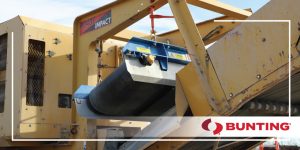Get in touch with us at our toll-free number 1-800-835-2526 or request a quote here:
Do You Need a Ferrite or Rare Earth Crossbelt Magnet?

Bunting’s permanent crossbelt magnets are some of our most popular magnetic separators. A crossbelt magnet is a simple, effective magnetic separator with a permanent magnet block positioned between two pulleys, around which rotates a self-cleaning belt. Installation of crossbelt magnets is simple as well. Crossbelt magnets are positioned above conveyors transporting material. When ferrous metal enters the crossbelt magnet’s magnetic field, it is lifted and removed from the greater flow of material. Some of the applications crossbelt magnets are used in include mines, quarries, recycling plants, and food processing facilities.
Traditionally, crossbelt magnets have been designed using ferrite magnets. Ferrite magnets are durable, economical magnets. In crossbelt magnets, the assembly process involves placing slabs or blocks of ferrite magnet material within a stainless-steel casing. This assembly is then “charged,” making it magnetic. In recent years, though, rare earth crossbelt magnets have started to be offered in addition to traditional ferrite crossbelt magnets.
What is a Rare Earth Crossbelt Magnet?
Rare earth crossbelt magnets use high-strength neodymium iron boron magnet blocks as opposed to lower-strength ferrite magnets. As described above, ferrite crossbelt magnets are magnetized after being assembled. Neodymium crossbelt magnets, on the other hand, have their magnetic block assembled “live”—that is, with the magnets already charged and magnetic.
Rare earth crossbelt magnets were developed to meet demand for a more lightweight crossbelt magnet that simultaneously provided increased magnetic strength. Stronger, lighter weight crossbelt magnets were particularly sought out for mobile plants such as crushers and screens. On the surface, it sounds as though rare earth crossbelt magnets are universally superior due to their greater strength and reduced weight. However, there are certain limitations of rare earth crossbelt magnets in comparison to their traditional ferrite cousins.
Potential Problems with Rare Earth Crossbelt Magnets
The phrase “stronger is not always better” is definitely applicable in the case of crossbelt magnets. When in operation, there are several potential disadvantages of rare earth crossbelt magnets when compared to ferrite crossbelt magnets, including:
A shallow magnetic field:
Some rare earth crossbelt magnets have shallow magnetic fields. This means that the magnetic field is only projected a short distance away from the bottom of the magnetic block and down into the conveyed material. This means that even if the rare earth magnetic field has more strength, it has a reduced reach-out. As a result, the rare earth crossbelt magnet must be positioned closer to the surface of the material being conveyed. Unfortunately, this is not always possible, and is often unsuitable in applications where there are large surges of material.
A very strong magnetic hold on the surface:
Rare earth crossbelt magnets have intense magnetic power concentrated on the surface of their magnetic block. However, this can be problematic in cases where larger tramp metal is being separated. In some situations, the magnetic attraction will be so strong that the captured metal will not be able to be automatically removed by the self-cleaning belt. This can lead to belt, bearing, and motor damage. When this metal has to be manually removed, it can lead to further health and safety concerns as manual removal of large tramp metal can be very dangerous.
Which Crossbelt Magnet Should I Get?
The purpose of this blog is not to cast rare earth crossbelt magnets in a poor light. There are many applications where rare earth crossbelt magnets are an excellent choice. For example, if the burden depth of the conveyed material is constant and small, then the rare earth crossbelt magnet can be positioned at a close range, where it will enable excellent separation of smaller tramp metal.
Similarly, if the metal contamination in the conveyed material is smaller in size, then rare earth crossbelt magnets often provide improved separation. However, it is important to note that other designs of magnetic separators, such as pulley magnets or drum magnets, may be more suitable depending on the application.
In general, if the tramp metal being handled is larger in size, the most suitable crossbelt magnet is the traditional ferrite version.
If you have questions about selecting the best crossbelt magnet for your unique application, we encourage you to reach out to us. Our magnet experts are happy to work with you to provide a customized crossbelt solution for your needs.
For more information, contact Bunting today.